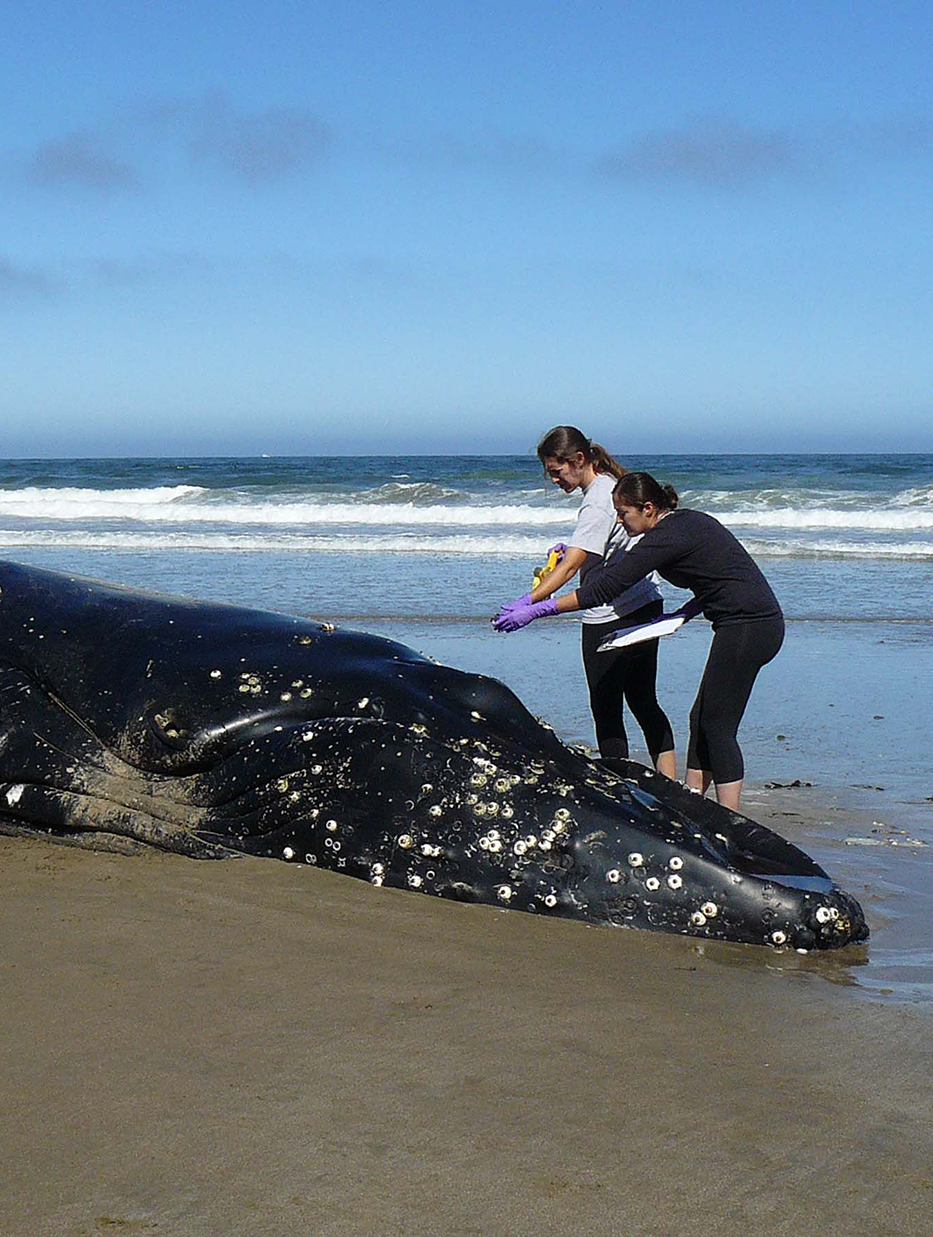Regina Asmutis-Silvia cannot forget the gaze of a humpback whale stranded on a beach in Chatham, Massachusetts. With fellow members of an International Wildlife Coalition team, she worked to dig under the whale to relieve the pressure of its body-weight on vital organs. They hoped the high tide would carry the whale back to sea, she remembers.
“We were trying to dig a hole around this massive animal; every time you walked by the head, this animal would just watch everything that you did.”
It has been about 20 years since that day she was called to action, but the experience has stayed with her. It informs her current work as executive director for Whale and Dolphin Conservation North America, advocating for the protection of marine mammals that continue to face numerous human-caused threats.
For nearly 50 years, ‘Save the Whales’ has been a battle cry among conservationists. These words helped bring about the international ban on commercial whaling in 1986, which helped humpbacks rebound from an estimated population low of 10,000 individuals to about 80,000 worldwide. In 1972, the Marine Mammal Protection Act established a national policy to prevent any species of marine mammals from declining beyond a specific threshold.
Even still, whales are dying in alarming numbers.
Since December 2022, there have been 69 large whale strandings along the U.S. Atlantic coast. So far this year, fifteen whales — 11 of them humpbacks — have been found dead off of New Jersey’s shores or on its beaches, according to the Marine Mammal Stranding Center. And those numbers do not account for those that die undiscovered at sea.
The impacts of these tragedies ripple out far beyond the ocean, as whales play a critical role in the global ecosystem. Their excrement provides essential nutrients to phytoplankton, which is necessary for our survival. “[Whales] afford the phytoplankton that gives the world half of its oxygen,” says Asmutis-Silvia.
And this makes preventing whale deaths all the more urgent. Identifying the main causes is key, and it’s not likely offshore wind, a claim that has been recently spread by conservative news outlets. “There are no known links between recent large whale mortalities and ongoing offshore wind surveys,” wrote Andrea Gomez, communications and public affairs specialist with National Oceanic and Atmospheric Administration (NOAA), in an email response to questions.
More likely, says Jenna Reynolds, President of New Jersey-based nonprofit Save Coastal Wildlife, “it’s ships ramming into whales, it’s commercial fishing from the nets and lines and it’s plastic pollution — those are the three big threats to our whales.” Experts are proposing solutions to address all three.

Forced migration
Local activists have observed that many of the whales stranded on the Jersey shore are young. According to Reynolds, 85-90% are juvenile humpbacks. She and other experts agree that warming waters are changing migratory patterns.
“What they feed on — the fish and the plankton — those populations are moving around,” she says. “We’re finding a lot of juvenile humpback whales because there’s food for them here and they don’t have to go north to compete with the adults. But the sad thing is that they don’t have the experience of dealing with ships.”
Especially in the New York Bight — the stretch of waters off the coast of Cape May up to the eastern tip of Long Island — necropsies are consistently showing that vessel strikes are the main culprit.
One way to lessen the number of ship strikes is by imposing lower speed limits for vessels. Last year, NOAA proposed changes to the speed rules they implemented in 2008 for vessels longer than 65 feet to protect critically endangered North Atlantic right whales. Right whales, numbering less than 350, are most at risk as they migrate during calving season, from mid-November to about mid-April. The proposed updates incorporate new, more comprehensive data on areas that present the highest strike risk and would expand to include boats 35 feet or larger.
Although some recreational and commercial boaters object to the lower speed limits, Asmutis-Silvia argues that the changes will also protect boaters. She mentioned a case in Florida where a 56-foot fishing vessel struck a mother right whale and her calf. The calf was killed instantly, and the mother was never seen again. The vessel sustained a loss of $1.2 million. “They had to ground the vessel before it completely capsized on site,” Asmutis-Silvia says.
“There’s a sort of ancillary benefit to the speed restrictions as well; it lowers emissions and it reduces noise on the ocean, which reduces the potential for collision,” she added.
Activists petitioned for a temporary implementation of the proposed speed rules last November at the start of right whale calving season, but as NOAA works through its regulatory process, the slow-down remains voluntary. Advocates hope that this year the rules will go into place in time. “There’s these little newborns that are very likely to be killed if they’re hit,” Asmutis-Silvia says.
Another change that would help whales is early adoption of ropeless fishing technology by commercial fishers, says Julia Singer, marine biologist at the international organization Oceana. The gear rests on the ocean floor and does not utilize ropes, she explained. Instead, when it makes its catch, fishers hit a button that inflates a buoy and brings it to the surface, thus eliminating the possibility of entanglements. The technology is new and still in development, but early trials suggest that fishers may lose less gear in storms and be able to fish in zones that are currently off limits.
Those who want to protect whales and other marine mammals can call their legislators to ask them to support the implementation of slow-down rules, reduce their use of plastics and participate in trash clean-ups.
Asmutis-Silvia also hopes that updates could be made to the Marine Mammal Protection Act (MMPA); the current mathematical formula to determine the number of whales that are ecologically necessary does not account for who the whales are within their communities, she says.
As climate change affects the marine environment, researchers have learned that some individual whales have distinct and valuable roles in their communities. Breeding-age females, of course, play a critical role in producing and nurturing calves. And some whales develop innovative hunting strategies, which others then adopt and share. Refining the MMPA policy to value how individual whales support the survival of their community could go a long way in protecting populations globally.










I can see that climate change has affected the whales, warming the waters, making their food relocate to locations where more ships travel for transpirtation.
But as for ship strikes. I see the mentality of the boats, both commercial and recreational, many times on the lookout on what is on the water. Not in the water. Underwater radar on ships would lesson the whale strikes, though that may be expensive. Education and being aware of thier surroundings. And slowing the ships down a bit. Not drastically especially these large recreational cruise ships and yachts.
I do not know much about boating sea creatures and the ocean ecosystem. But any solution has to be a balance of all factors.
TRP.
The Divine Doofus says whale mortality is directly linked to windmills. This was not mentioned in this article.
It was but it is a Trumpy lie sprayed out by lobster lobbies. Enough with the alternate reality and lies, and respect life for once!